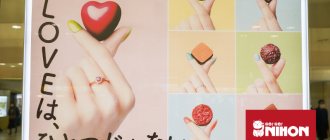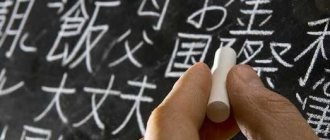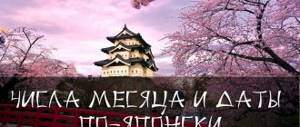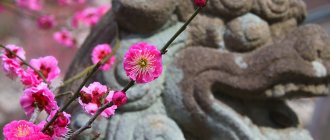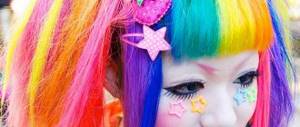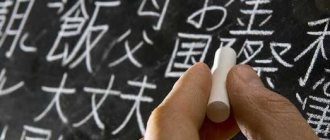What are keys and why are they needed?
In order to find a word from European languages in the dictionary, it is enough to arm yourself with a good dictionary and find the desired word by its initial letters.
We can't do this with Japanese words because of the hieroglyphic system. The most common are dictionaries compiled according to the key system. What to do in this case? How to find the right one among thousands of squiggles? After all, the mandatory minimum of hieroglyphs that you need to know to live in Japan includes 2136 kanji. At first glance, it may seem that hieroglyphs are a chaotic collection of sticks and lines, the order of which can only be remembered by an exceptional mind. It's actually not that scary. Each, even the most unimaginable hieroglyph, can be decomposed into several simple symbols. These simple symbols are the keys , or in Japanese 部首 (bushyu), where 部 is “element/part” and 首 is “head/neck”. That is, the key , or radical , is the main element in kanji, which helps to classify and find a Japanese character by spelling in the dictionary.
Most dictionaries, including online ones, use a key-based recognition system for Japanese characters. If you are trying to find a kanji whose meaning or pronunciation you don’t know, and you don’t have a phone at hand where you can draw the character of interest in an online translator, then the only thing left for you is to find the hieroglyph by radical. The more you understand them, the easier it will be for you to search for Japanese characters using keys.
Each radical has its own meaning. So, some keys can be independent hieroglyphs , for example, 人 (person), 心 (heart) or 手 (hand). When used as part of other kanji, they can be written in full or abbreviated. For example, the independent character 水 (water) as a radical can be written unchanged, as in the kanji 泉 (spring), or shortened to 氵, as in the word “pond” - 湖.
Sometimes the meaning of the keys helps you remember the meaning of the kanji itself. For example, the character 休, which means “rest”, “to rest”, consists of the keys “person” and “tree”. While working in the field, people rest (where?) under a tree. Or another example - the character 安 (cheap) consists of the elements “woman” and “roof”. Women under a roof (at home) are cheap. But this method is not appropriate in all cases. Sometimes you have to memorize abstract concepts.
Often, without knowing what a kanji means, its key can be used to guess what area the symbol may belong to. For example:
- hieroglyphs with the radical “fish” - 魚 will most likely mean the names of fish: 鮭 (salmon), 鯨 (whale);
- Kanji with the key "water" - 氵 - can mean anything related to water: 泳 (swim), 池 (pond);
- with the key “disease” - 疒 - the words 痛 (pain) and 症 (symptoms) will appear;
- and the radical "grass" - 艹 - can be found in characters associated with vegetation: 花 (flower) or 茶 (tea).
In the following examples, the right side of the kanji is the same, but the left side is different. The left side is the key. Notice how each of them conveys its meaning to the hieroglyph:
- 時: The radical of this kanji is 日 (sun, day, time) and the character itself means “time”;
- 詩: Its main element is 言 (words, speak) and the meaning of this kanji is “poetry”, “poem”;
- 持: The radical of this kanji is 扌 (hand), and its meaning is “to hold.”
Therefore, it is recommended to learn the meaning of all radicals. But you need to remember one thing. As you know, kanji came to the Japanese language from China. However, they did this while undergoing some changes. Sometimes a Chinese character was assigned to a Japanese word "just like that", regardless of the meaning. Also, the Japanese “invented” 70 of their own hieroglyphs, so it’s still better to check the meanings of kanji in a dictionary.
Keys are divided into strong and weak. If the element is always or almost always a radical, then it is a strong key (for example, "fire" - 火). Weak ones are those elements that are rarely used as keys, that is, most often they act simply as a separate kanji (for example, “inch” - 寸).
There are a total of 214 traditional keys . They are grouped in a key table, where they are arranged by the number of traits. Each key is assigned its own number. It is recommended to remember the number of radicals in order to quickly find the desired hieroglyph. However, in our opinion, there is no need to sit and cram all 214 keys at once, because not even all Japanese will remember them from memory. In addition, many of them are no longer used. The most important radicals will be memorized gradually as you read the texts. After some time of regular study of the language, you will be able to scan characters with ease and Japanese radicals will not seem difficult. The ability to recognize keys in kanji and count features will allow you to use dictionaries, both electronic and paper, to search for unfamiliar characters.
Each paper dictionary of Japanese characters contains a complete table of radicals , in which they are arranged in order of increasing strokes from one to seventeen.
Radicals of Japanese characters, PNG image.
To recognize Japanese characters online, translators with built-in OCR systems (scan text in images and provide a translation) or handwritten character recognition systems are most often used. The most popular example of such a translator is Google Translate. However, at the moment there are many alternatives. For example, the interactive database of Japanese characters Kanji Alive, where you can search for kanji by the name of the key, the number of strokes in it, its meaning or position.
Another useful service is the famous online dictionary Jisho. It, just like the paper versions, has a search by radicals.
To find a word this way, you need:
- determine which kanji element is a radical;
- count the number of his features;
- find the desired key in the table by the number of traits and click on it;
- after this, a complete list of Japanese characters that contain the selected radical will automatically appear;
- the characters will be arranged in the same way as the keys (according to the number of strokes), so first you need to count the total number of strokes in the kanji;
- and then find the desired symbol in the table of Japanese characters that appears.
First, select a few simple kanji (for example, the already familiar 時, 詩, 持) and try to find out their reading yourself using a dictionary, using the search by radicals.
How to remember reading hieroglyphs
Although in the Chinese language most of the characters fall into the category of phonoid ideograms, however, the character does not contain a direct indication of reading, like phonetic languages. Another difficulty of the Chinese language is the widespread phenomenon of homophony: due to the limited number of syllables (just over 400), different characters can be read the same, which creates certain difficulties in understanding spoken language. However, it is very convenient to memorize a whole series of hieroglyphs that have the same reading.
♦ Read more: Homophones in Chinese and some traditions associated with them
In the early days of my study of the Chinese language, I usually remembered the tone by some line: a horizontal line at the top of the character meant the first tone, a slanted line to the left meant the second tone, a horizontal line at the bottom meant the third tone, and a slanted or tilted line to the right meant the fourth tone. Although there were hieroglyphs where the required line was not found.
A completely different situation arises in the Japanese language, where there are two types of reading hieroglyphs: onnoe, which came from the Chinese language, and kunnoe, traditional Japanese. Thus, one hieroglyph can have up to 5 or more different readings! In different phrases, hieroglyphs can be read differently.
For example, in Japanese the words “yesterday” 昨日 and “tomorrow” 明日, which contain the same sign 日 (day, sun), are read completely differently: kino: and ashita, respectively. In the phrase “every day”, “daily” 毎日 will be read mainichi, “third number”, “three days” 三日- mikka. Although, in theory, all four words should end the same.
That is why the only effective way to remember reading hieroglyphs in both Chinese and Japanese is by cramming : repeating them repeatedly to yourself and out loud, trying to remember the melody. In the Chinese language, in my opinion, this is easier to do due to the presence of phonideograms and the general repetition of syllables; in Japanese it is a little more difficult.
Rules for determining the key in a hieroglyph
Kanji can have one or more keys. Therefore, when searching for a hieroglyph, the most important thing is to determine which element is the key. There are some recommendations for this:
1) First you need to make sure that the hieroglyph itself is not a key by counting the features. And if kanji is not the key, then you can safely move on to the next points.
2) If a complex hieroglyph consists of two elements, one of which is on the right and the other on the left, then most likely the key will be the left element. If you did not find the left element in the key table, then the right one will be the key.
3) If in a hieroglyph consisting of two elements, one of them covers the other from several sides, then the key is often the covering element.
4) If in a complex hieroglyph consisting of two elements, one of which is at the top and the other at the bottom, then you need to look for the top one first.
5) After you have found the key, you can start searching for the hieroglyph by the number of features.
But it should be remembered that at first, searching for keys will take a lot of time, and the correct identification of the key will come with experience. Ideally, you need to know the entire key table to quickly and accurately find the key.
Methods for entering hieroglyphs
Due to the growing popularity of the Chinese language recently, I decided to share my experience and small developments in the principles and methods of entering these most mysterious characters. First, a little theory about what it is and why it exists.
Introduction
What is Chinese writing? Words are formed from one or more hieroglyphs, in turn, a hieroglyph can be simple or composed of a key (radical) and graphic elements. Example: respectful greeting 您好 (Nín hǎo), the literal translation of which is “You are good.” The first compound character consists of 2 - 你 (Nǐ)- “You” and 心 (Xīn) “heart”. 你 - also consists of 2 parts, the key 亻 (short for 人 (rén) - person) and the grapheme 尔 ((ěr) - not used independently in modern language). In brackets I indicated the pronunciation of the hieroglyph, pinyin (pīnyīn), the dashes above the vowels are tones, in the northern dialect of China “Putonghua” there are 4 of them + neutral. Putonghua (also called Mandarin) is spoken in Beijing and the northeast, and is being tried to spread as a standard spoken language throughout the PRC. There are many dialects, and even if you manage to learn Beijing, you still won’t understand Shanghai. But don’t be too alarmed - written language is the same everywhere, so in QQ, on forums and reading those. documentation you will not feel any particular discomfort. That is, as everyone has already guessed, the pronunciation of a hieroglyph has little to do with its spelling. It won’t work if you open an unfamiliar text and simply take it and speak it out without even understanding the meaning. So, if a crazy thought wanders into our smart heads to learn Chinese, I warn you right away, you will have to LEARN hieroglyphs (read - cram), and learn them with pronunciation and tones. So, we started learning, created a new folder on the computer for our materials and are trying to name it. In Russian or English? Not professional! Open Google Translate and translate “Chinese” and get the beautiful “中国的”. Congratulations, you have mastered the 1st input method. But I hasten to disappoint you, nothing of the kind. Chinese language – 汉语(Hànyǔ). Now open Translate again, select translation from Chinese -> Russian and enter “hanyu” on the English layout, not forgetting to check the “Allow phonetic typing” box, a window will appear in which you can select the desired option using the navigation keys.
Pinyin
Yes, entering characters using the phonetic script we just used is called pinyin.
This is the most common input method in China. Quite fast and simple. It is enough to know the pronunciation of the word and remember its outline. There are a dozen programs written on Windows that will help us communicate with our brothers in their native language using Pinyin. I preferred 2 of them: Google Pinyin, Sogou pinyin. For the average person, the difference is not significant; the interface of both is in Chinese. Sogou irritates you with frequent advertising and a bunch of unnecessary services included. Google's has no such shortcomings. Both add a new layout, switching to which when you type, a window similar to Google Translater pops up. For example, let's try to write 我喜爱的哈伯尔阿哈伯尔 (Wǒ xǐ'ài de hā bó ěr ā hā bó ěr). Switch to the Chinese layout and boldly enter woxiaide (my favorite). While we were entering, the program was selecting a suitable version of a phrase that made sense. It is worth noting that there are a lot of hieroglyphs with the same pronunciation, and it is better to enter them in portions depending on the degree of complexity of the phrase. Press the spacebar and voila - the treasured 我喜爱的 appears on the screen.
Further more difficult. You can’t just enter proper names. There are no letters. Therefore, the name of the city of Volgograd will look like 伏尔加格勒 and read Fú'ěrjiā gé lè. That is, not only do they not have the sounds “v”, “r”, but they also do not have the opportunity to write a combination of several sounds if there is no such hieroglyph with a similar sound. That is why the name Misha will consist of 2 hieroglyphs 米沙 (Mǐ Shā) - literally translated as “rice” and “sand”. Panic? Can not understand anything? I assure you, the Chinese too. When I asked her to check whether I had written the word 哈伯尔阿哈伯尔 (Habrahabr) correctly, my Chinese friend fell into a stupor. That this is a proper name is clear only from the context. So we can only reluctantly introduce the next portion of pinyin “habo” for the cherished declaration of love for our project
and from the drop-down list select “哈伯” and space using the up and down keys. Next, follow the thumbnail “er” - 尔, space, “a” - 阿, space, again “habo” - note that the desired characters are already in the first place, you can immediately press space and “er” - 尔. That's it, let's check. 我喜爱的哈伯尔阿哈伯尔 (Wǒ xǐ'ài de hā bó ěr ā hā bó ěr). What are the advantages of this method - you do not need to draw the hieroglyph itself, which takes much more time. There is no need to follow the tones. You need to remember what the hieroglyph looks like and what it sounds like. By the way, there is a very big difference between: knowing what a hieroglyph looks like and knowing how to write it. And so we will begin to learn how to write them.
Handwriting
It's a little easier here. Imagine. We are walking along the street, and on the fence, instead of the usual notes, there is something like 出口. And how should we deal with this? We don’t know these characters in Pinyin, which means the previous method is not helpful to us. We open a wonderful site and next to the “Search” button we see a pencil, click, a whole field for art opens, and that’s where we need to redraw our hieroglyphs one by one.
Here is such a recognizer. Here you can see both the pronunciation and translation. So next time, if we get lost in one of the shopping centers in Beijing, we can safely ask the question 出口在哪儿? Well, or at least look for a sign with such cracks.
The advantages of this method are the search for unfamiliar hieroglyphs. You can even get used to it and write at a tolerable speed. The method is especially practical on modern mobile devices with touchscreens, and is implemented extremely conveniently. There is a subtype of the handwriting method, or
Stroke
If you don’t have the ability to draw, or don’t have the desire, you can turn to this method. Its essence is that all hieroglyphs are written using simple squiggles and lines. Each such line has its own name, for example, the horizontal “heng”, the vertical “shu”, the vertical downwards then the horizontal to the right, as you might guess “shu heng”. All sorts of oblique “pie” and “na”, dots “dian”,... here is a table for you to intimidate.
And, accordingly, there is a rule in what order these components of the hieroglyph should be written (if very exaggerated, then from top to bottom, from left to right). Knowing this rule, as well as the correspondence between squiggles and letters (it may differ in different programs, on my smartphone everything is more beautiful) you can just as easily enter it.
Pros: You don’t have to be the happy owner of a device with a touchscreen; you can assign each element its own key. You don't need to draw, you don't have to enter all the elements. Usually after 3-4 times the required hieroglyph comes out.
Wubi
The method is complex, and not all Chinese know how to use it. But not all Chinese can read and write at all. So if you want to win the hearts of millions and have a speed of about 150 hieroglyphs per minute, this is the place for you. To begin with, you will have to learn the keys (radicals), there are not many of them, about 250. Once we learn it, we will be able to decompose the hieroglyph into its components (graphemes). Example 输: 车, 人, 一, 月, 刂. Now you have to learn the location of these components on the keyboard. Here, too, everything is simple: 5 zones, marked with different colors, serial numbers of zones and numbers corresponding to the number of traits in the grapheme.
This means that in order to enter our hieroglyph 输, we will have to find 4 keys on the keyboard corresponding to the graphemes: “车” - L, “人” - W, “一” - G, “刂” - J. (if there are more than 4 graphemes, the first 3 and the last are used). It would seem that everything is simple, but there are many hieroglyphs consisting of 2 or 3 graphemes, the key combinations of which very often coincide. Here we will additionally have to learn 4 groups into which all hieroglyphs are divided (basic, hieroglyphs with unconnected graphemes, with connected ones and with intersecting ones), and the serial number of the last line of the hieroglyphs, which make up the code for identifying the desired hieroglyph.
There are several other hybrid input methods that are not as common; speech recognition. But for productive learning without the special expense of memorizing unnecessary things, my choice fell on Pinyin. It's not just that I'm very lazy. Since childhood, we have been taught to write in letters that correspond to the sounds of speech, and pinyin in this regard is very similar to traditional phonetic writing.
If someone thought that all this was not rational, believe me, you are not the first to come to this idea. The mentality is different. Their path is thorny and indirect, but whatever they do, they do it with great perseverance and dedication. I wish the same for you.
How keys are located in hieroglyphs
Radicals are divided into seven groups and, depending on their position, have their own names. Below you will find examples with different key positions.
Hen
These are the keys located on the left side. These include:
- Nin-ben (person) → 亻: 仕、休、代、住、体、作、何、伝;
- Tsuti-ben (earth) → 土: 地、場、塩、増;
- Onna–hen (woman) → 女: 妹、姉、姫、娘、婚、嫁;
- Gyōnin-ben (walking man) → 彳: 役、彼、待、後、徒、得、復;
- Rissin-ben (heart) → 忄: 情、快、怖、性;
- Te-hen (hand) → 扌: 打、持、指、払;
- Ki-hen (tree) → 木: 村、材、松、林、校.
Tsukuri
Located on the right. Among them you can find such radicals as:
- Rittō (sword) → 刀: 刊、判、別、利、副;
- Akubi (slit) → 欠: 次、歌、歓.
Kanmuri
These radicals are located on top:
- U-kanmuri (crown) → 宀: 守、安、完、宇、宙、定、宝、実、室;
- Take-kanmuri (bamboo) → 竹: 笑、第、筆、等、算;
- Kusa-kanmuri (grass) → 艹: 花、若、英、茶、草.
Ashi
The name of these keys is literally translated “legs”. Therefore, it is easy to remember that they are located below:
- Hitoashi (human feet) → 儿: 元、兄、先、光、党;
- Kokoro (heart) → 心: 思、急、息、悲、意、悪、感.
Tare
Tare covers the kanji from the top and left. It seems as if this radical is “sliding” from top to bottom:
- Shikabane (flag) → 尸: 尼、尾、局、居、届、屋;
- Ma-dare (cliff with a dot) → 广: 広、床、底、店、府、度、庫、庭.
Nyō
The key occupies the left and bottom sides, as if “twisting” at the bottom of the hieroglyph. For example:
- Shin-shyō (road) → ⻌: 返、近、辺、通、連、週、道;
- En-nyō (wide step) → 廴: 廷、建.
Kamae
This key covers the entire hieroglyph, “embracing” it. Please note that the kamae is not always completely closed. There are several varieties of this radical:
- Kuni-kamae (box) → 囗: 困、団、囲、図、国、園;
- Mongamae (gate) → 門: 開、間、関、閉.
The order of writing hieroglyphs
In Japanese, it is very important to be able to count strokes in hieroglyphs and know the order in which they are written. This determines whether you will be able to find kanji using keys in dictionaries in the future.
Rules for writing graphic elements:
- when drawing a hieroglyph, you need to imagine that you are writing it in a square;
- The hieroglyph must be written from top to bottom and from left to right;
- horizontal lines are written first (always from left to right);
- vertical and inclined are written from top to bottom;
- if a hieroglyph has a central, right and left part, then the central part should be written first;
- the enclosing element is written first;
- vertical lines crossing the hieroglyph in the center are written last;
- when counting features, it is necessary to remember that one feature is taken to be an element written together by hand, and not the printed form of the hieroglyph (for example, in the key “field” 田 there are not 6 features, but 5, since the top and right walls are written in one movement).
Having learned the order of writing radicals and understanding the whole principle, you can easily guess how the rest of the hieroglyph is written.
How many hieroglyphs are there in total?
The character in the classical written language Wenyan 文言 usually meant a whole word. In modern Chinese, words mostly consist of one or two, rarely three or more characters. Therefore, there are a lot of hieroglyphs.
In 1994, the dictionary “Sea of Chinese Characters” by Zhonghua Zihai 中華字海 was published, which contains 85,568 characters! True, the vast majority of them can be found only a few times in classical literary works. Conventional bilingual dictionaries contain about 6-8 thousand hieroglyphs, among which there are also many rare ones. More complete explanatory dictionaries contain about 10-20 thousand characters.
It is believed that to understand 80% of modern ordinary Chinese text , it is enough to know the 500 most common characters, knowledge of 1000 characters gives an understanding of approximately 91% of the text, and 2500 characters - 99% of the text. In order to pass the highest level Chinese language exam for foreigners, HSK 6, you need to know just under 3,000 characters. To read specialized scientific or classical literature, you need to understand a larger number of hieroglyphs.
However, you must keep in mind that even if all the hieroglyphs in the text are familiar to you, you will not always completely understand the meaning of what is written. You also need to know words—various word combinations of hieroglyphs. The Chinese language uses quite a lot of abbreviations, when stable phrases of several characters are reduced to shorter ones.
For example, the phrase “Beijing University” 北京大学 Běijīng dàxué is shortened to 北大 Běidà, which literally means “northern big”. Another difficulty in the Chinese language is the use of chengyu成语, an idiom typically consisting of four characters. If each sign is translated literally, the meaning of what is said may not be understood. There are special Chenyu dictionaries, as well as collections of stories that explain the meaning of the most famous idioms. Translations of chengyu can also be found in dictionaries.
♦ On topic: What is chengyu
In the Japanese language, there is a mandatory list of Joyo kanji characters 常用漢字, accepted by the Japanese Ministry of Education as sufficient for everyday use. It consists of 2,136 kanji (hieroglyphs) and includes 1,006 kyoiku kanji, which are studied by students in 6-year elementary school and 1,130 kanji, which are taught in middle school.
List of hieroglyphic keys
Below is a list of translated keys. They are indicated in the variation in which they are most used in modern language. Please note that not all radicals are independent hieroglyphs. Also, students often forget that not every hieroglyph is a radical.
| Number of traits | Hieroglyph number | Hieroglyph | Reading | Meaning |
| 1 trait | 1 | 一 | いち | one |
| 2 | 丨 | ぼう | rod, rod | |
| 3 | 丶 | てん | dot | |
| 4 | 丿 | てん | katakana sign "BUT" | |
| 5 | 乙 | おつ | fish hook | |
| 6 | 亅 | はねぼう | thorn, thorn, mustache | |
| 2 traits | 7 | 二 | に | two |
| 8 | 亠 | なべぶた | lid | |
| 9 | 人 | ひと | Human | |
| 10 | 儿 | にんにょう | human legs | |
| 11 | 入 | いる | enter | |
| 12 | 八 | はちがしら | eight | |
| 13 | 冂 | まきがまえ | showcase, counter | |
| 14 | 冖 | わかんむり | crown | |
| 15 | 冫 | にすい | water drops | |
| 16 | 几 | つくえ | table | |
| 17 | 凵 | うけばこ | open box | |
| 18 | 刀 | かたな | sword | |
| 19 | 力 | ちから | force | |
| 20 | 勹 | つつみがまえ | wrap, wrap | |
| 21 | 匕 | さじのひ | spoon | |
| 22 | 匚 | はこがまえ | open side box | |
| 23 | 匸 | かくしがまえ | hide | |
| 24 | 十 | じゅう | cross | |
| 25 | 卜 | ぼくのと | Magic wand | |
| 26 | 卩 | ふしづくり | seal | |
| 27 | 厂 | がんだれ | cliff | |
| 28 | 厶 | む | I | |
| 29 | 又 | また | moreover, in this case | |
| 3 traits | 30 | 口 | くち | mouth |
| 31 | 囗 | くにがまえ | box | |
| 32 | 土 | つち | earth, soil | |
| 33 | 士 | さむらい | samurai | |
| 34 | 夂 | ふゆがしら | winter, start | |
| 35 | 夊 | すい | shuffle | |
| 36 | 夕 | ゆうべ | evening | |
| 37 | 大 | だい | big | |
| 38 | 女 | おんな | woman | |
| 39 | 子 | こ | child | |
| 40 | 宀 | うかんむり | crown | |
| 41 | 寸 | すん | glue | |
| 42 | 小 | ちいさい | small | |
| 43 | 尢 | まげあし | curved "big" | |
| 44 | 尸 | しかばね | flag | |
| 45 | 屮 | てつ | old grass | |
| 46 | 山 | やま | mountain | |
| 47 | 巛 | まがりがわ | curved "river" | |
| 48 | 工 | たくみ | skill, worker | |
| 49 | 己 | おのれ | snake | |
| 50 | 巾 | はば | cloth | |
| 51 | 干 | はす | dry | |
| 52 | 幺 | いとがしら | short thread | |
| 53 | 广 | まだれ | cliff with a point | |
| 54 | 廴 | いんにょう | long stride | |
| 55 | 廾 | にじゅうあし | twenty | |
| 56 | 弋 | しきがまえ | ceremony | |
| 57 | 弓 | ゆみ | bow weapon) | |
| 58 | ヨ | けいがしら | pig head | |
| 59 | 彡 | さんづくり | bunch | |
| 60 | 彳 | ぎょうにんべん | walking man | |
| 61 | 心 | りっしんべん | heart | |
| 62 | 戈 | かのほこ | halberd | |
| 63 | 戸 | とびらのと | door | |
| 64 | 手 | て | hand | |
| 65 | 支 | しんよう | branch | |
| 66 | 攴 | ぼくづくり | folding chair | |
| 67 | 文 | ぶんにょう | sentence, phrase | |
| 68 | 斗 | とます | ladle, scoop | |
| 69 | 斤 | おの | axe | |
| 70 | 方 | ほう | side, direction | |
| 71 | 无 | むにょう | curved "paradise" | |
| 72 | 日 | にち | day, sun (location: Hen) | |
| 73 | 曰 | にち | flat sun (location: Ashi) | |
| 74 | 月 | つき | moon | |
| 75 | 木 | き | tree | |
| 76 | 欠 | あくび | gap, gap | |
| 77 | 止 | とめる | stay | |
| 78 | 歹 | がつへん | death | |
| 79 | 殳 | ほこつくり | windy again | |
| 80 | 毋 | なかれ | mother | |
| 81 | 比 | くらべるひ | foot race | |
| 82 | 毛 | け | wool | |
| 83 | 氏 | うじ | clan | |
| 84 | 气 | きがまえ | spirit | |
| 85 | 水 | みず | water | |
| 86 | 火 | ひ | fire | |
| 87 | 爪 | つめ | claw | |
| 88 | 父 | ちち | father | |
| 89 | 爻 | めめ | mix, double X | |
| 90 | 爿 | しょうへん | left-handed "stencil" | |
| 91 | 片 | かた | single sided stencil | |
| 92 | 牙 | きばへん | fang | |
| 93 | 牛 | うし | cow | |
| 94 | 犬 | いぬ | dog | |
| 96 | 王 | おう | king | |
| 5 traits | 95 | 玄 | げん | mysterious |
| 96 | 玉 | うし | jewel | |
| 97 | 瓜 | うり | watermelon | |
| 98 | 瓦 | かわら | tiles | |
| 99 | 甘 | あまい | sweet | |
| 100 | 生 | うまれる | life | |
| 101 | 用 | もちいる | use | |
| 102 | 田 | た | rice field | |
| 103 | 疋 | ひき | number | |
| 104 | 疒 | やまいだれ | disease | |
| 105 | 癶 | はつがしら | "tent" with dots | |
| 106 | 白 | しろ | white | |
| 107 | 皮 | けがわ | hide | |
| 108 | 皿 | さら | plate | |
| 109 | 目 | め | eye | |
| 110 | 矛 | むのほこ | halberd | |
| 111 | 矢 | や | arrow | |
| 112 | 石 | いし | stone | |
| 113 | 示 | しめす | show, indicate | |
| 114 | 禹 | う | Yu the Great | |
| 115 | 禾 | のぎ | tree with two branches | |
| 116 | 穴 | あな | slit, cut | |
| 117 | 立 | たつ | stand | |
| 6 traits | 118 | 竹 | たけ | bamboo |
| 119 | 米 | こめ | rice | |
| 120 | 糸 | いと | thread | |
| 121 | 缶 | ほとぎ | can, watering can | |
| 122 | 网 | あみがしら | net | |
| 123 | 羊 | ひつじ | sheep | |
| 124 | 羽 | はね | feathers | |
| 125 | 老 | おい | old man | |
| 126 | 而 | しかして | rake | |
| 127 | 耒 | らいすき | tree with three branches | |
| 128 | 耳 | みみ | ear | |
| 129 | 聿 | ふでづくり | writing brush | |
| 130 | 肉 | にく | meat | |
| 131 | 臣 | しん | vassal | |
| 132 | 自 | みずから | myself | |
| 133 | 至 | いたる | highest point, climax | |
| 134 | 臼 | うす | mortar | |
| 135 | 舌 | した | language | |
| 136 | 舛 | ます | dance | |
| 137 | 舟 | ふね | ship | |
| 138 | 艮 | うしとら | good | |
| 139 | 色 | いろ | color | |
| 140 | 艸 | くさ | grass | |
| 141 | 虍 | とらかんむり | tiger | |
| 142 | 虫 | むし | insect | |
| 143 | 血 | ち | blood | |
| 144 | 行 | ぎょう | go | |
| 145 | 衣 | ころも | cloth | |
| 146 | 襾 | にし | west | |
| 7 traits | 147 | 見 | みる | see |
| 148 | 角 | つの | corner, horn | |
| 149 | 言 | ことば | speak | |
| 150 | 谷 | たに | valley | |
| 151 | 豆 | まめ | bean | |
| 152 | 豕 | いのこ | pig | |
| 153 | 豸 | むじな | badger | |
| 154 | 貝 | かい | seashell | |
| 155 | 赤 | あか | red | |
| 156 | 走 | はしる | run | |
| 157 | 足 | あし | leg | |
| 158 | 身 | み | body | |
| 159 | 車 | くるま | wheel | |
| 160 | 辛 | からい | spicy | |
| 161 | 辰 | しんのたつ | the Dragon | |
| 162 | 辷 | しんにゅう | road | |
| 163 | 邑 | むら | village | |
| 164 | 酉 | ひよみのとり | sake | |
| 165 | 釆 | のごめ | dice | |
| 166 | 里 | さと | village | |
| 8 traits | 167 | 金 | かね | metal |
| 168 | 長 | ながい | long | |
| 169 | 門 | もん | gates | |
| 170 | 阜 | ぎふのふ | village | |
| 171 | 隶 | れいづくり | slave | |
| 172 | 隹 | ふるとり | old bird | |
| 173 | 雨 | あめ | rain | |
| 174 | 青 | あう | green, blue | |
| 175 | 非 | あらず | injustice | |
| 9 features | 176 | 面 | めん | surface |
| 177 | 革 | かくのかわ | leather | |
| 178 | 韋 | なめしがわ | burned skin | |
| 179 | 韭 | にら | leek | |
| 180 | 音 | おと | sound | |
| 181 | 頁 | おおがい | head | |
| 182 | 風 | かぜ | wind | |
| 183 | 飛 | とぶ | fly | |
| 184 | 食 | しよく | food | |
| 185 | 首 | くび | neck | |
| 186 | 香 | においこう | smell | |
| 10 traits | 187 | 馬 | うま | horse |
| 188 | 骨 | ほね | bone | |
| 189 | 高 | たかい | high | |
| 190 | 髟 | かみがしら | long hair | |
| 191 | 鬥 | とうがまえ | broken gate | |
| 192 | 鬯 | ちよう | aromatic herbs | |
| 193 | 鬲 | かく | tripod | |
| 194 | 鬼 | おに | daemon | |
| 11 features | 195 | 魚 | うお | fish |
| 196 | 鳥 | とり | bird | |
| 197 | 鹵 | ろ | salt | |
| 198 | 鹿 | しか | deer | |
| 199 | 麥 | むぎ | wheat | |
| 200 | 麻 | あさ | linen | |
| 13 features | 201 | 黄 | きいろ | yellow |
| 202 | 黍 | きび | millet | |
| 203 | 黒 | くろ | black | |
| 204 | 黹 | ふつ | sew | |
| 205 | 黽 | べん | green frog | |
| 206 | 鼎 | かなえ | teapot on three legs | |
| 207 | 鼓 | つづみ | drum beat | |
| 208 | 鼠 | ねずみ | mouse | |
| 14 features | 209 | 鼻 | はな | nose |
| 210 | 齊 | せい | equal | |
| 15 traits | 211 | 齒 | は | tooth |
| 16 features | 212 | 龍 | りゅう | the Dragon |
| 213 | 龜 | かめ | turtle | |
| 17 features | 214 | 龠 | やく | flute |
To advance your kanji learning, check out our article on the three scripts. In it you will find Japanese characters for beginners with translation . Knowing the radicals with which they are formed, you will notice that it has become easier to navigate them. Now, every time you see a hieroglyph, try to immediately look for the key element in it. Soon this will become a very simple task.
How to learn all these Japanese characters keys? We invite you to check out our free course on effectively learning hieroglyphs, and our basic course Japanese for Beginners in three steps will help you consolidate your knowledge.
Keys of Japanese characters (kanji) - table and definition rules. In the article, we explained what kanji keys are and how to use them to look up characters in a dictionary.


